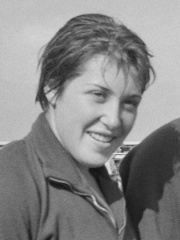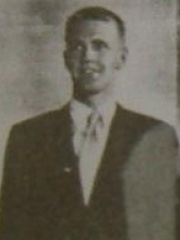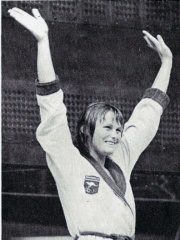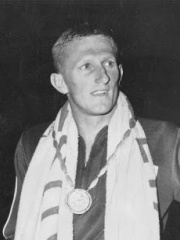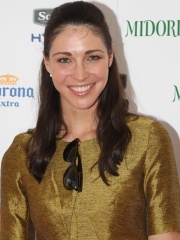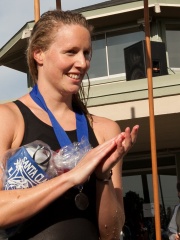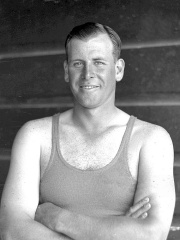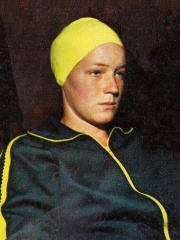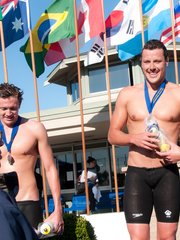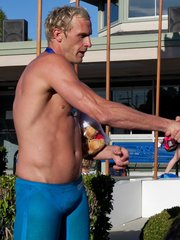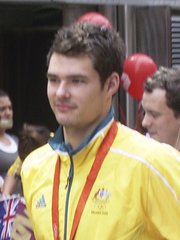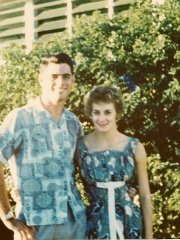
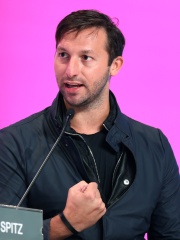
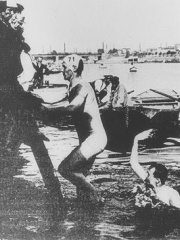
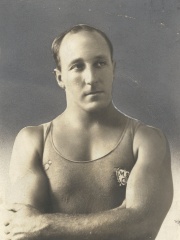
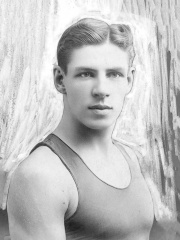
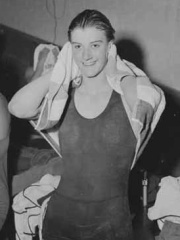

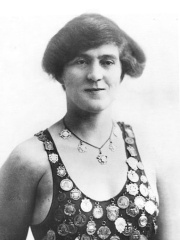
The Most Famous
SWIMMERS from Australia
Top 10
The following people are considered by Pantheon to be the top 10 most legendary Australian Swimmers of all time. This list of famous Australian Swimmers is sorted by HPI (Historical Popularity Index), a metric that aggregates information on a biography's online popularity. Visit the rankings page to view the entire list of Australian Swimmers.

1. John Devitt (1937 - 2023)
With an HPI of 56.26, John Devitt is the most famous Australian Swimmer. His biography has been translated into 24 different languages on wikipedia.
John Thomas Devitt, AM (4 February 1937 – 17 August 2023) was an Australian sprint freestyle swimmer of the 1950s and 1960s, who won a gold medal in the 100-metre freestyle at the 1960 Summer Olympics in Rome. He won in controversial circumstances, being awarded the gold medal despite the timekeepers recording a slower time than the American silver medallist Lance Larson. He also claimed a gold medal at the 1956 Summer Olympics in Melbourne, in the 4×200-metre freestyle relay.

2. Ian Thorpe (b. 1982)
With an HPI of 55.83, Ian Thorpe is the 2nd most famous Australian Swimmer. His biography has been translated into 55 different languages.
Ian James Thorpe (born 13 October 1982) is an Australian retired swimmer who specialised in freestyle, but also competed in backstroke and the individual medley. He has won five Olympic gold medals, the second most won by any Australian after fellow swimmer Emma McKeon. With three gold and two silver medals, Thorpe was the most successful athlete at the 2000 Summer Olympics, held in his hometown of Sydney. At the age of 14, Thorpe became the youngest male ever to represent Australia, and his victory in the 400 metre freestyle at the 1998 Perth World Championships made him the youngest-ever individual male World Champion. After that victory, Thorpe dominated the 400 m freestyle, winning the event at every Olympic, World, Commonwealth and Pan Pacific Swimming Championships until his break after the 2004 Olympics in Athens. At the 2001 World Aquatics Championships, he became the first person to win six gold medals in one World Championship. Aside from 13 individual long-course world records, Thorpe anchored the Australian relay teams, numbering the victories in the 4 × 100 m and the 4 × 200 m freestyle relays in Sydney among his five relay world records. His wins in the 200 m and 400 m and his bronze in the 100 m freestyle at the 2004 Summer Olympics made him the only male to have won medals in the 100–200–400 combination. He acquired the nickname "Thorpedo" because of his speed in swimming. Thorpe announced his retirement from competitive swimming in November 2006, citing waning motivation; he made a brief comeback in 2011 and 2012. In total, Thorpe has won eleven World Championship gold medals; this is the fifth-highest number of gold medals won by any male swimmer. Thorpe was the first person to have been named Swimming World Swimmer of the Year four times, and was the Australian Swimmer of the Year from 1999 to 2003. His athletic achievements made him one of Australia's most popular athletes, and he was recognised as the Young Australian of the Year in 2000.

3. Frederick Lane (1880 - 1969)
With an HPI of 55.53, Frederick Lane is the 3rd most famous Australian Swimmer. His biography has been translated into 23 different languages.
Frederick Claude Vivian Lane (2 February 1880 – 14 May 1969) was an Australian swimmer who competed at the 1900 Summer Olympics. Lane, from Manly, New South Wales, was four years old when his brother saved him from drowning in Sydney Harbour, whereupon he decided to learn to swim. Later, he attended high school at Saint Ignatius' College, Riverview. After breaking many Australasian swimming records, Lane moved to England to compete in the English Championships in 1899. He was the first Australian to represent his country in swimming at the Olympic Games, when he competed at the 1900 Summer Olympics in Paris, and won two gold medals. He first won the 200 metres freestyle, clearly beating Hungarian Zoltán Halmay. His second final was just 45 minutes later, the discontinued 200 metre obstacle event, where he beat Austrian Otto Wahle. After the Olympics, Lane stayed in England for another two years working for a legal firm in Blackpool while he continued to swim and break records. In July 1902, he won a 100-yard race and became the first person to record one minute dead for that distance. In August, he swam 220 yards in 2 minutes 28.6 seconds, which in 1974 was ratified by FINA as the first World Record for 200 metres. In October, he broke the one-minute barrier for 100 yards in 59.6 seconds. On returning to Australia, Lane became a master printer and a partner in a printing and stationery firm on Bridge Street. He married in 1908. He died in 1969 at Avalon Beach. In 1969, Lane was honoured by the International Swimming Hall of Fame in Fort Lauderdale, Florida. On 10 December 1985, Lane was inducted into the Sport Australia Hall of Fame. In 2022, he was an inaugural inductee of the Swimming Australia Hall of Fame.

4. Cecil Healy (1881 - 1918)
With an HPI of 53.27, Cecil Healy is the 4th most famous Australian Swimmer. His biography has been translated into 18 different languages.
Cecil Patrick Healy (28 November 1881 – 29 August 1918) was an Australian freestyle swimmer of the 1900s and 1910s, who won silver in the 100 m freestyle at the 1912 Summer Olympics in Stockholm. He also won gold in the 4 × 200 m freestyle relay. He was killed in the First World War at the Somme during an attack on a German trench. Healy was the second swimmer behind Frederick Lane to represent Australia in Swimming and has been allocated the number "2" by Swimming Australia on a list of all Australians who have represented Australia at an Open International Level.
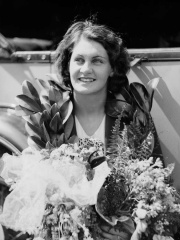
5. Clare Dennis (1916 - 1971)
With an HPI of 53.24, Clare Dennis is the 5th most famous Australian Swimmer. Her biography has been translated into 20 different languages.
Clara "Clare" Dennis (7 March 1916 – 5 June 1971), later known by her married name Clare Golding, was an Australian breaststroke swimmer of the 1930s who won the gold medal in the 200-metre breaststroke at the 1932 Summer Olympics in Los Angeles, California.

6. Harold Hardwick (1888 - 1959)
With an HPI of 52.98, Harold Hardwick is the 6th most famous Australian Swimmer. His biography has been translated into 18 different languages.
Harold Hampton Hardwick (14 December 1888 – 22 February 1959) was a versatile Australian sports star of the early 20th century – an Olympic gold medal swimmer, national heavyweight boxing champion, and a state representative rugby union player. He later became a colonel in the Australian Imperial Force. Hardwick was on the winning team of the 4x200-metre freestyle relay at the 1912 Summer Olympics and won bronze medals in the 400-metre and 1500-metre freestyle.

7. Faith Leech (1941 - 2013)
With an HPI of 52.61, Faith Leech is the 7th most famous Australian Swimmer. Her biography has been translated into 18 different languages.
Faith Yvonne Leech (31 March 1941 – 14 September 2013) was an Australian freestyle swimmer who won a gold medal in the 4×100–metre freestyle relay and bronze in the 100-metre freestyle at the 1956 Summer Olympics in Melbourne. A tall and lean swimmer known for her elegant technique, Leech started swimming as a child to build strength after a series of stomach disorders in her infancy. She quickly rose to prominence after breaking a string of age group records. In 1955, she became the youngest swimmer to win an Australian title, claiming victory in the 110-yard freestyle at the age of 13. She twice broke the Australian record in the 100-yard freestyle in late 1955, thereby positioning herself as a leading contender for Olympic selection in 1956. Leech's preparation was hindered by illness, which forced her out of the 1956 Australian Championships, but she recovered to gain Olympic selection in both the 100-metre freestyle and the corresponding relay. Leech produced a late surge to take bronze in the individual event and seal an Australian trifecta, before swimming the second leg in the relay to help secure an Australian victory in world record time. Leech retired after the Olympics at the age of 15; she cited anxiety caused by racing as one of the main factors in her decision.

8. Leslie Boardman (1889 - 1975)
With an HPI of 52.57, Leslie Boardman is the 8th most famous Australian Swimmer. His biography has been translated into 17 different languages.
Leslie Boardman (2 August 1889 – 23 November 1975) was an Australian freestyle swimmer of the 1910s. As a member of the Australasia combined team of Australia and New Zealand athletes, Boardman won a gold medal in the 4×200-metre freestyle relay at the 1912 Summer Olympics in Stockholm, Sweden. Although little is known about Boardman, he never won any Australian championships and was not among the original selections for the Stockholm Olympics. E.G. Findlay was originally named in the team, but presumably due to lack of financing, Boardman later assumed his position in the team. According to records, he did not place at the 1912 Australian Championships and came fourth in the 220-yard freestyle at the New South Wales Championships. It is hypothesized that he was chosen because he was a teammate at the Sydney Swimming Club of Harold Hardwick and Cecil Healy. Boardman competed in the 100-metre freestyle at the Stockholm Olympics where he won his heat, but came fourth in the second round and was eliminated. In the 4×200-metre freestyle relay, he swam the third leg as the team of Hardwick (Australia), Healy (Australia) and Malcolm Champion (New Zealand) defeated the United States team for the gold medal. He was also signed up to compete at plain high diving competition, but did not compete.

9. Fanny Durack (1889 - 1956)
With an HPI of 52.21, Fanny Durack is the 9th most famous Australian Swimmer. Her biography has been translated into 23 different languages.
Sarah Frances "Fanny" Gately (née Durack; 27 October 1889 – 20 March 1956) was an Australian competition swimmer. From 1910 until 1918 she was the world's greatest female swimmer across all distances from freestyle sprints to the mile marathon.
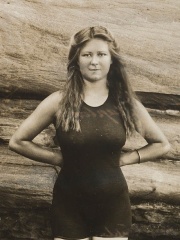
10. Mina Wylie (1891 - 1984)
With an HPI of 51.13, Mina Wylie is the 10th most famous Australian Swimmer. Her biography has been translated into 18 different languages.
Wilhelmina "Mina" Wylie (27 June 1891 – 6 July 1984) was one of Australia's first two female Olympic swimming representatives, along with friend Fanny Durack.
People
Pantheon has 103 people classified as Australian swimmers born between 1880 and 2005. Of these 103, 91 (88.35%) of them are still alive today. The most famous living Australian swimmers include Ian Thorpe, Sandra Morgan, and Jon Henricks. The most famous deceased Australian swimmers include John Devitt, Frederick Lane, and Cecil Healy. As of April 2024, 17 new Australian swimmers have been added to Pantheon including Peter Evans, Jon Sieben, and Blair Evans.
Living Australian Swimmers
Go to all RankingsIan Thorpe
1982 - Present
HPI: 55.83
Sandra Morgan
1942 - Present
HPI: 50.71
Jon Henricks
1935 - Present
HPI: 50.07
Ian O'Brien
1947 - Present
HPI: 50.01
Shane Gould
1956 - Present
HPI: 49.10
David Theile
1938 - Present
HPI: 48.60
Peter Evans
1961 - Present
HPI: 46.81
Lyn McClements
1951 - Present
HPI: 46.08
Gail Neall
1955 - Present
HPI: 44.06
Giaan Rooney
1982 - Present
HPI: 43.69
Bronte Barratt
1989 - Present
HPI: 43.12
Petria Thomas
1975 - Present
HPI: 42.41
Deceased Australian Swimmers
Go to all RankingsJohn Devitt
1937 - 2023
HPI: 56.26
Frederick Lane
1880 - 1969
HPI: 55.53
Cecil Healy
1881 - 1918
HPI: 53.27
Clare Dennis
1916 - 1971
HPI: 53.24
Harold Hardwick
1888 - 1959
HPI: 52.98
Faith Leech
1941 - 2013
HPI: 52.61
Leslie Boardman
1889 - 1975
HPI: 52.57
Fanny Durack
1889 - 1956
HPI: 52.21
Mina Wylie
1891 - 1984
HPI: 51.13
Boy Charlton
1907 - 1975
HPI: 50.41
Kevin Berry
1945 - 2006
HPI: 49.72
Beverley Whitfield
1954 - 1996
HPI: 46.98
Newly Added Australian Swimmers (2025)
Go to all RankingsPeter Evans
1961 - Present
HPI: 46.81
Jon Sieben
1966 - Present
HPI: 39.38
Blair Evans
1991 - Present
HPI: 34.49
Patrick Murphy
1984 - Present
HPI: 33.82
Felicity Galvez
1985 - Present
HPI: 33.80
Taylor McKeown
1995 - Present
HPI: 32.95
Hayden Stoeckel
1984 - Present
HPI: 32.82
Matthew Abood
1986 - Present
HPI: 32.63
Christian Sprenger
1985 - Present
HPI: 32.20
James Roberts
1991 - Present
HPI: 31.65
Alice Tait
1986 - Present
HPI: 30.44
Tommaso D'Orsogna
1990 - Present
HPI: 30.16
Overlapping Lives
Which Swimmers were alive at the same time? This visualization shows the lifespans of the 12 most globally memorable Swimmers since 1700.

